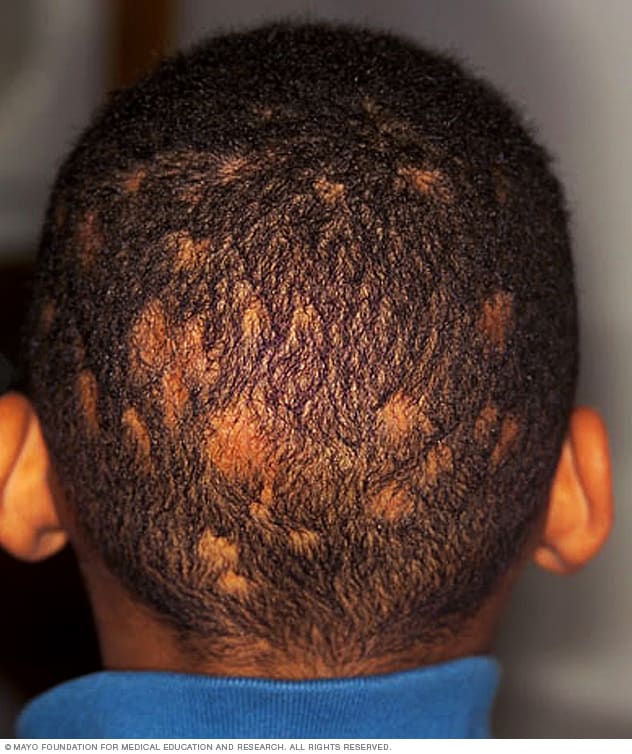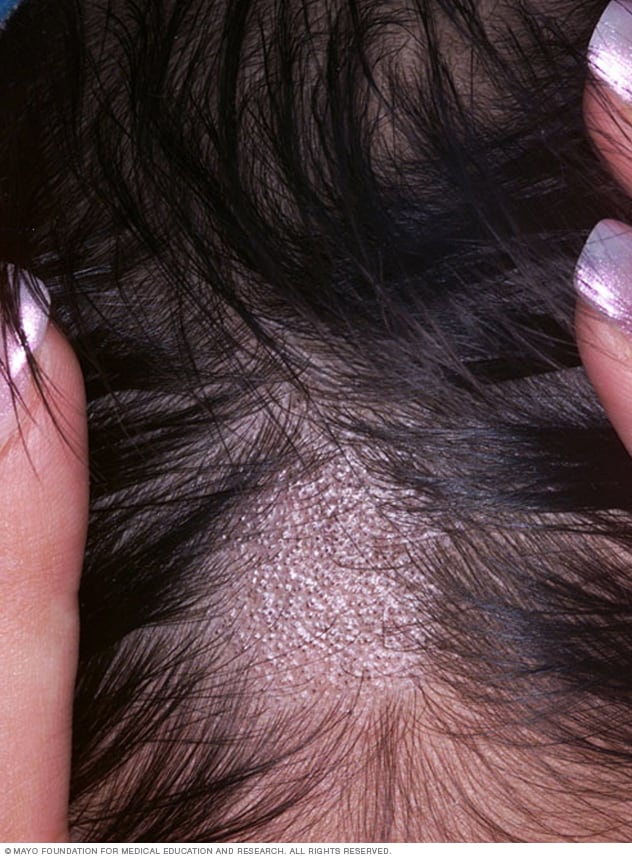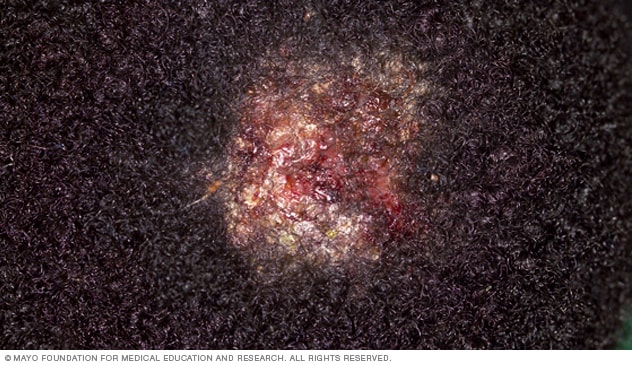Ringworm (scalp) - Symptoms and causes - Mayo Clinic News Network
Overview
Ringworm of the scalp

Ringworm of the scalp
Ringworm of the scalp appears as round patches where the hair has broken off at or just above the scalp. These bald-looking patches slowly grow larger.
Close-up of ringworm of the scalp

Close-up of ringworm of the scalp
Up close, the scalp can look scaly and silvery with patches of broken hair. You may also see small black dots if the hair has broken off right at the scalp.
Ringworm of the scalp (tinea capitis) is a rash caused by a fungal infection. It usually causes itchy, scaly, bald patches on the head. Ringworm gets its name because of its circular appearance. No worm is involved.
Ringworm of the scalp is a contagious infection. It's most common in toddlers and school-age children. Tinea capitis is related to athlete's foot (tinea pedis), jock itch (tinea cruris) and ringworm of the body (tinea corporis).
Medication taken by mouth can kill the fungus that causes ringworm of the scalp. Medicated shampoos may help keep a person from spreading the infection to others.
Products & Services
Symptoms
Signs and symptoms of ringworm of the scalp may include:
- One or more round, scaly or inflamed patches where the hair has broken off at or near the scalp
- Patches that slowly get bigger and have small, black dots where the hair has broken off
- Brittle or fragile hair that can be easily broken or pulled out
- Tender or painful areas on the scalp
When to see a doctor
Several conditions affecting the scalp may have a similar appearance. See your child's doctor if your child has any hair loss, scaling or itchiness of the scalp, or other unusual appearance of the scalp. It's important to get an accurate diagnosis and prompt treatment with prescription medicine. Nonprescription creams, lotions and powders won't get rid of ringworm of the scalp.
From Mayo Clinic to your inbox
Sign up for free, and stay up to date on research advancements, health tips and current health topics, like COVID-19, plus expertise on managing health.
To provide you with the most relevant and helpful information, and understand which information is beneficial, we may combine your email and website usage information with other information we have about you. If you are a Mayo Clinic patient, this could include protected health information. If we combine this information with your protected health information, we will treat all of that information as protected health information and will only use or disclose that information as set forth in our notice of privacy practices. You may opt-out of email communications at any time by clicking on the unsubscribe link in the e-mail.
Thank you for subscribing!
You'll soon start receiving the latest Mayo Clinic health information you requested in your inbox.
Sorry something went wrong with your subscription
Please, try again in a couple of minutes
Causes
Ringworm of the scalp is caused by a common fungus. The fungus attacks the outer layer of skin on the scalp and the hair. This causes those hairs to break. The condition can be spread in the following ways:
- Human to human. Ringworm often spreads through direct skin-to-skin contact with an infected person.
- Animal to human. You can contract ringworm by touching an animal with ringworm. Ringworm can spread while petting or grooming dogs or cats with ringworm. Ringworm is fairly common in kittens, puppies, cows, goats, pigs and horses.
- Object to human. It's possible for ringworm to spread by contact with objects or surfaces that an infected person or animal has recently touched. This includes items such as clothing, towels, bedding, combs and brushes.
Risk factors
Risk factors for ringworm of the scalp include:
- Age. Ringworm of the scalp is most common in toddlers and school-age children.
- Exposure to other children. Outbreaks of ringworm are common in schools and child care centers where the infection easily spreads with close contact.
- Exposure to pets. A pet, such as a cat or a dog, can have the infection without showing any signs. Children can get the infection by touching the animal.
Complications
Kerion

Kerion
Ringworm of the scalp can cause kerion — a severe, painful inflammation of the scalp. Kerion appears as soft, raised swellings that drain pus.
Some people with ringworm of the scalp may develop a severe inflammation called kerion. Kerion appears as soft, raised swellings that drain pus and cause thick, yellow crusting on the scalp.
With kerion, the hair falls out or can be easily pulled out. The condition may be caused by an overly vigorous reaction to the fungus and can lead to scarring and permanent hair loss.
Prevention
Ringworm of the scalp is difficult to prevent. The fungus that causes it is common, and the condition is contagious even before symptoms appear. Take these steps to reduce the risk of ringworm:
- Educate yourself and others. Be aware of the risk of ringworm from infected people or pets. Tell children about ringworm, what to watch for and how to avoid the infection.
- Shampoo regularly. Be sure to wash your child's scalp regularly, especially after haircuts. Some scalp conditioning products, such as coconut oil and pomades with selenium, might help prevent ringworm of the scalp.
- Keep skin clean and dry. Be sure children wash their hands, including after playing with pets. Keep shared areas clean, especially in schools, child care centers, gyms and locker rooms.
- Avoid infected animals. The infection often looks like a patch of skin where fur is missing. If you have pets or other animals that commonly carry ringworm, ask your veterinarian to check them for the infection.
- Avoid sharing personal items. Teach children not to let others use their clothing, towels, hairbrushes, sports gear or other personal items.
Jan. 22, 2022
- AskMayoExpert. Tinea capitis. Mayo Clinic; 2021. Accessed Sept. 10, 2021.
- Ringworm. Centers for Disease Control and Prevention. https://www.cdc.gov/fungal/diseases/ringworm/index.html. Accessed Sept. 10, 2021.
- Kelly AP, et al., eds. Pediatrics. In: Taylor and Kelly's Dermatology for Skin of Color. 2nd ed. McGraw-Hill; 2016. https://accessmedicine.mhmedical.com. Accessed Sept. 10, 2021.
- Schmitt BD. Ringworm. In: Pediatric Telephone Protocols: Office Version. 16th ed. American Academy of Pediatrics; 2019.
- Office of Patient Education. Fungal infection: Ringworm of the scalp. Mayo Clinic; 2010.
- Ferri FF. Tinea capitis. In: Ferri's Clinical Advisor 2022. Elsevier; 2022. https://www.clinicalkey.com. Accessed Sept. 10, 2021.



Comments
Post a Comment